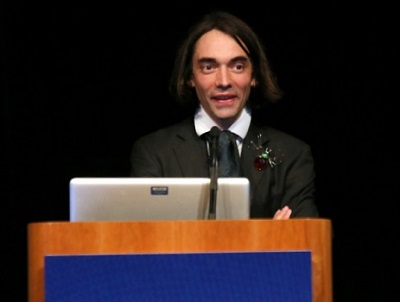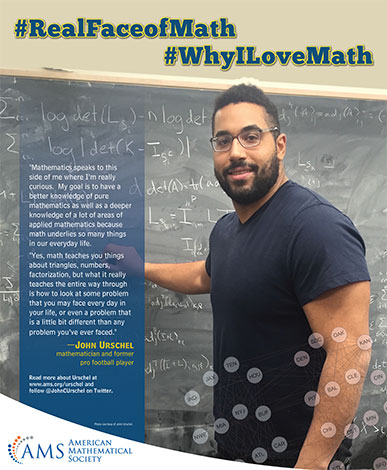
Top Math Stories in the Media - 2017
These stories about mathematics and mathematicians had an impact on the mathematics community and the general public due to their coverage in major or many media, and their human interest.
Maryam Mirzakhani, May 3, 1977-July 14, 2017

Maryam Mirzakhani, the only woman to win a Fields Medal, died on July 14 at the age of 40. Mirzakhani was a professor at Stanford University and a highly original mathematician who made a host of striking contributions to geometry and dynamical systems. Her work bridges several mathematical disciplines--including hyperbolic geometry, complex analysis, topology, and dynamics--and in return deeply influenced them all. Media around the world covered her life and mathematical contributions.
See A Tribute to Maryam Mirzakhani, a page of tributes and obituaries, and Tony Phillips' Take on Math in the Media, Maryam Mirzakhani (August 2017) and Maryam Mirzakhani in Nature (October 2017).
Hidden Figures, the film and the mathematicians

The Hidden Figures film was released in late December 2016 with much pre-publicity. The AMS panel including the book author Margot Lee Shetterly, and one of the mathematicians who made contributions to the United States' aeronautics and space programs, Christine Darden, at the 2017 Joint Mathematics Meetings in January 2017 drew a standing room only crowd. During 2017 the film's stars appeared on TV programs to talk about the inspiring women mathematicians, and the book and film inspired book clubs, and schools to bring students to the film, and even a set of LEGOs of some of the featured women--all covered by the media. In May NASA honored 97-year-old mathematician Katherine Johnson by dedicating a building in her name at the space agency's Langley Research Center in Hampton, Virginia. (Photo, left to right: Margot Lee Shetterly, Christine Darden, and Ulrica Wilson at the Hidden Figures panel held at the 2017 Joint Mathematics Meetings.)
See on Math in the Media: "On Hidden Figures and Black Girls Code," by Rachel Crowell; "West Virginia Honors Mathematician Katherine Johnson;" "Hidden Figures, Reviewed by Fern Y. Hunt," (Notices of the AMS, June/July 2017); and "The Mathematics And Mathematicians Of Hidden Figures," by Anna Haensch.
Daniel Rothman on mass extinction

On a decidedly non-cheery note, Daniel Rothman of MIT published a paper in Science Advances on "a math formula to predict when the next mass extinction or global catastrophe could occur," which piqued the interest of media. (Photo by John M. Hayes.)
See on Math in the Media "Daniel Rothman on predicting mass extinction," by Claudia Clark, and "Mathematical Expression of a Global Environmental Catastrophe," by Daniel H. Rothman (Notices of the AMS, February 2017)
Math and Gerrymandering
 During the summer of 2017 the Metric Geometry and Gerrymandering Group, led by the mathematician Moon Duchin, met at Tufts University, where they discussed new mathematical tools to analyze and change gerrymandering. (Images: Top: a plausible districting scheme for Pennsylvania, dividing the state into 18 Congressional districts of equal population. Bottom: Pennsylvania's actual Congressional districts. Images from PNAS 114 2860-2864.)
During the summer of 2017 the Metric Geometry and Gerrymandering Group, led by the mathematician Moon Duchin, met at Tufts University, where they discussed new mathematical tools to analyze and change gerrymandering. (Images: Top: a plausible districting scheme for Pennsylvania, dividing the state into 18 Congressional districts of equal population. Bottom: Pennsylvania's actual Congressional districts. Images from PNAS 114 2860-2864.)
See on Tony Phillips' Take on Math in the Media, "Math and the gerrymander," and other stories tracked on Math in the Media including, "The Math Behind Gerrymandering and Wasted Votes,"by Patrick Honner, Quanta Magazine, and "Investigating Gerrymandering and the Math Behind Partisan Maps," by Patrick Honner and Michael Gonchar, The New York Times.
Enigma Machine sold at auction

"A rare Enigma machine used by Nazi Germany during World War II was sold at auction Tuesday for 45,000 euros ($51,500)," to an anonymous online bidder, reported CNN. As noted by Smithsonian, "the Enigma machine is the most storied cryptography device in modern history." Adopted by the German armed services during World War II to encrypt messages, the Allied Forces eventually broke the code--a story told in the 2014 film, The Imitation Game. Various versions of the Enigma machine have become collectors items and this auctioned machine was particularly noteworthy because the owner had purchased it at a flea market for only 100 euros ($114). (Photo by E. David Luria.)
See on Math in the Media "Enigma machine sold at auction."
Villani elected to the French Parliament

Mathematician and Fields Medalist Cédric Villani, 43, received 69% of the vote in a constituency south of Paris to become a new member of France's National Assembly. In an interview published in Science, Villani said, "I never recognized myself in any national political movement. But Macron’s party is enthusiastically pro-European, which has become very rare among national parties in France. It also went very much against the old political tradition of systematically attacking opponents during the presidential election; instead it promoted benevolence, pragmatism, and progress. And the party welcomed nonpoliticians with professional expertise." (Photo: Villani at the 2013 Joint Mathematics Meetings.)
See on Math in the Media "Villani elected to the French National Assembly."
Weapons of Math Destruction

The subtitle of this book by Cathy O'Neil is "How Big Data Increases Inequality and Threatens Democracy." In interviews on radio and in print O'Neil stresses that people don't understand the mathematical models, algorithms, and scoring systems and impact us in so many ways--college admissions, incarcerations, employment, insurance, elections, baseball team recruitment, social networks, financial systems, and education. In an interview in EdSurge she said, "Algorithms, at the end of the day, are typically scoring systems. As soon as you have a scoring system, then you can game the scoring system. If you game it enough, it'll stop making sense. That's essentially what happened." And so the book prompted lots of reviews and sales in 2017. (Photo courtesy Cathy O'Neil.)
Math in the Media tracked and linked to reviews on an ongoing basis, including "Weapons of Math Destruction, book review: Democracy in the age of the algorithm" in ZDNet; 'Weapons of math destruction' in +Plus Magazine; "'Weapons of Math Destruction’: A Data Scientist's Warning About Impacts of Big Data" on EdSurge; and a review by Mary Poovey in Notices of the AMS September 2017 issue.
Yves Meyer Received 2017 Abel Prize

In March the Norwegian Academy of Science and Letters announced Yves Meyer as the winner of this year’s Abel Prize “for his pivotal role in the development of the mathematical theory of wavelets.” The news of this, one of the most prestigious and generous awards for mathematics, was covered in Nature, Forbes, Inria, The Guardian, Business France, The Irish times, Scientific American, and other news and science media.
See "On the 2017 Abel Prize," by Claudia Clark and Tony Phillips' Take, "Yves Meyer's Abel Prize, celebrated in Nature," on Math in the Media.
John Urschel Retires from Pro Football to be a Full-time Mathematician

John Urschel has been covered in the media for a few years due to his being both a pro football player for the Baltimore Ravens and a graduate student in mathematics at MIT. In 2017 he decided to retire from football at age 26 to concentrate on mathematics. The timing coincided with reports of widespread brain damage in the sport, but Urschel says his decision was based more on wanting to pursue his mathematics.
See John Urschel - Mathematician and Former Pro Football Player, including articles on his decision to retire from professional football to become a full-time mathematician.
Eugenia Cheng on TV, radio and in publications

Eugenia Cheng combines baking with higher-dimensional category theory, and her enthusiasm for mathematics and its connections to music, baking, and everyday life is contagious--a reason she's asked to appear on tv, radio and in print. "Math is amazing and we have to start treating it that way." (Photo: Still from a video, University of Sheffield.)
Math in the Media tracked and linked to reviews of her book, How to Bake Pi, as well as her interviews in The Guardian, The Chronicle of Higher Education, on WBEZ radio, and the PBS News Hour.
Pi Day

Each year Pi Day (3.14) attracts media attention, with stories and radio segments on its history, puzzles, celebrations, games (think hula hoops and yo-yos), and of course, baking (pies of course). Students and mathematicians--and this year, NASA--engaged in some pretty fun activities in honor of the number.
See the round-up of of this year's media coverage on Math in the Media.
Op-Eds and Letters to the Editor
We also acknowledge some of the fine opinion pieces and letters to the editor that appeared in 2017: "Who Invented ‘Zero’?," by Manil Suri, The New York Times, October 7, 2017; "Democracy has roots in math and science," by Edwin O'Shea, Richmond Times Dispatch, October 5, 2017; "The creative process of mathematics," by Jeff Shriner, Daily Camera (Boulder, CO), August 25, 2017; "Why aren't people listening to scientists?," by Marcus du Sautoy, Los Angeles Times (Op-Ed), April 23, 2017; "The World's Most Beautiful Mathematical Equation," by Richard A. Friedman, The New York Times (Opinion), April 15, 2017. See more on Communicating Mathematics in the Media: A Guide.
More math in the media
See also PBS Infinite Series (videos on YouTube), "What's Going on in this Graph?" (a new series on The New York Times Science, by Rachel Crowell), Global Math Week, which took the world by storm via social media prior to and during the week of October 10; Alex Bellos's Monday Puzzles in the Science section of The Guardian), My Favorite Theorem (interviews with mathematicians conducted by Evelyn Lamb and Kevin Knudson), and Dance Your PhD (a contest for graduate students, and in 2017 the winning video was "Representations of the braid groups,” by Nancy Scherich, University of California, Santa Barbara).
See Top Math Stories in the Media - 2016, and see AMS Math in the Media, your central source for news of mathematics and mathematicians, Tony Phillips' Take, links to reviews of math books, plays, films, and television, and summaries by past AMS-AAAS Media Fellows and the AMS Public Awareness Office. Also, follow @amermathsoc on Twitter for ongoing sharing of news.
--- Annette Emerson, AMS Public Awareness Officer

